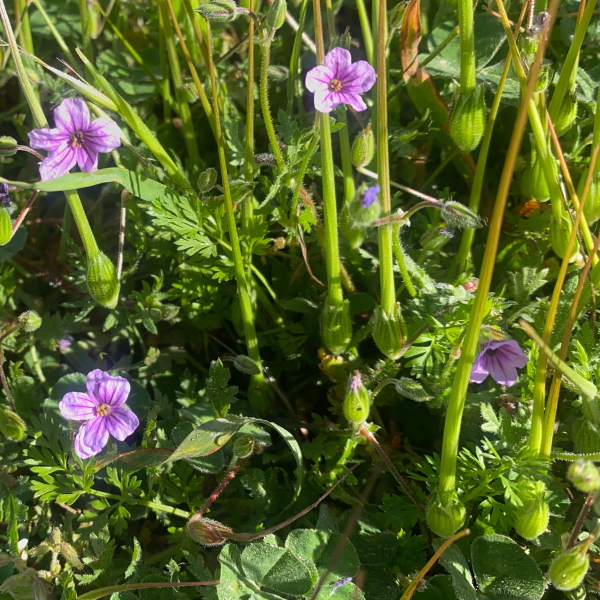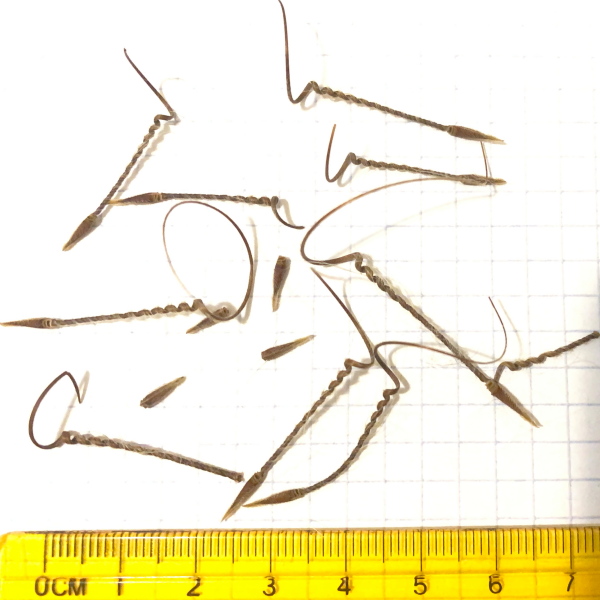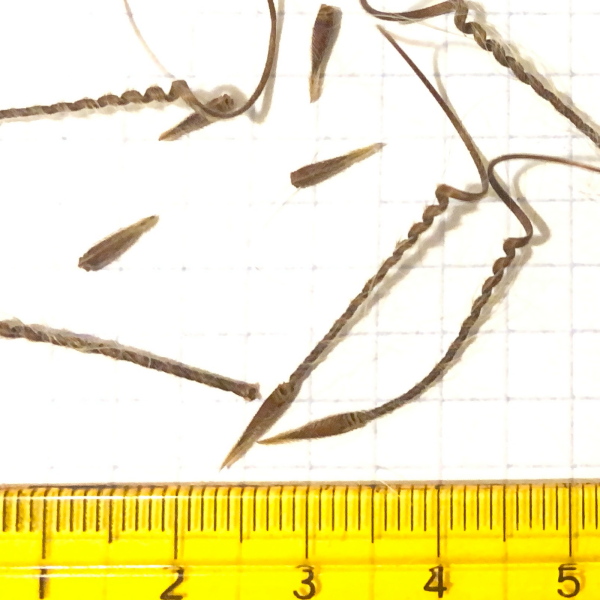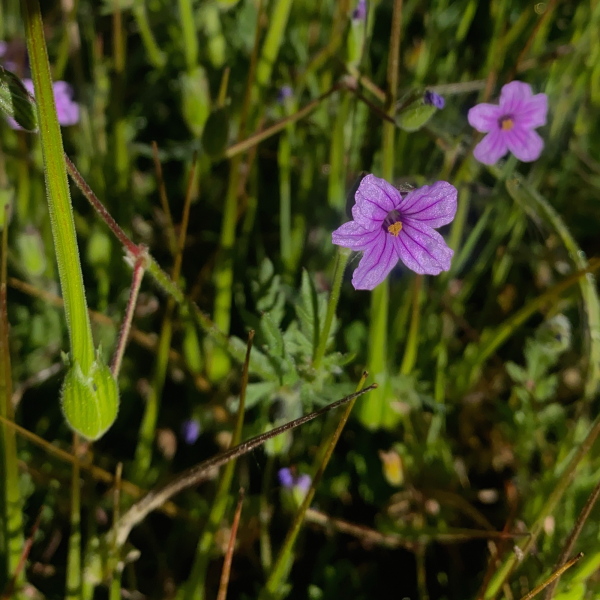

You already know that you need to check the fur on your dog’s legs, paws and toes for nasty burrs and seeds that may have hitched a free ride. These hitchhikers become more of an issue the longer they remain undiscovered, tangling themselves tighter as they work their way deeper.
In this article, I want to shine the spotlight on one of them, the corkscrew seed from the Filaree plant (Erodium cicutarium). After reading what follows, you may decide to inspect your dog more thoroughly. You may even take the next step, and have all the fur on your dog’s legs, feet and toes, and in between his toes and toe pads, trimmed short for spring. At the very least, you’ll be aware of the hazard to your dog from this fiendish little devil.
Vicious Little Corkscrew Seeds of the Erodium cicutarium
In our home, we call these little devils the “Curly Whirlies.” They’re also known as corkscrews. They have two parts, a spiral tail, called an “awn,” and an arrowhead shaped seed pod with a sharp tip. The tightly coiled end of the awn connects to the seed pod.
The coils of the awn wind up and unwind with changes in humidity. Winding up and unwinding drills the pointed seed into the soil.
The same drilling action can force the pointy seeds deep into your dog’s fur coat. They seem perfectly designed for tangling in dog fur.
The coiled awn often breaks off after drilling the seed into the soil, or into your dog’s fur. This means that when searching your dog’s fur, you’ll find the awns with and without their pointed seeds, along with the pointed seeds on their own.
The Erodium cicutarium Mother Plant aka Corkscrew, Filaree, Stork’s Bill, Heron Bill, Curly Whirly
Having just moved to Sonoma County, I’d never seen these little seed coils before.
I eventually traced them back to their mother plant, the Filaree. The “Filaree” is a dainty, pretty little pink flower that would be right at home beside the snowy little blossoms of Edelweiss from the Sound of Music.
I noticed that large areas of a local park were carpeted with these little flowers (Ragle Ranch Park just East of Sebastopol). When the flowers go to seed, they form pods that resemble a “Stork’s Bill,” or a “Heron Bill.” When ripe, the pods burst open to release five seeds, each connected to a spiral seed tail.
Erodium cicutarium originates from Eurasia and NE Africa. It’s an invasive species to California, Victoria, Tasmania and Western Australia, where it prefers dry soil.
In Australia, the seeds are known as “Corkscrews.” I figure that Aussies would be familiar with the seed tails. Sheep’s wool has got to be the perfect material for trapping corkscrew seeds in nasty tangle.
The Coiled Awns of the Erodium cicutarium will form Mats and Tangles in Your Dog’s Fur
Removing them is easy at first, before they have a chance to get wound up in the finer fur. If you don’t catch them early, then what would take a few seconds becomes a protracted ordeal, like untangling a bird’s nest of fishing line. Left in for days, they tangle up in the fur to form a tag or a mat that needs to be clipped out.
It Pays to Check Your Dog’s Fur at the End of Every Walk and to Trim Their Fur Short
When checking our dog’s legs, paws and toes after every walk, we’ve found up to 20 of these little devils in a single go.
I’ve found corkscrews in the fur all over our dog, a newfie doodle. However, most of them lodge below his knees or hocks, on the feathery fur on the back of his legs and in between his toes.
May and June seem to be the worst months.
The trick is to find them soon enough, when it’s quite easy to pull them out of the fur. I recommend you stand your dog up on a picnic table, to check his fur at the end of his walk, before you leave the park. When they first get picked up by your dog’s fur, you can pretty much whisk them off your dog, before they have a chance to tangle themselves into his undercoat.
To make it easier to check his fur for corkscrews more effectively and thoroughly (and to easily whisk them off), I recommend you have his fur trimmed short for the spring season.
The longer you leave the corkscrews in, the more dire the problem grows (just as for burrs, foxtail seeds, or barley grass seeds). They progressively tangle deeper into the fur and become more difficult to extricate. The awns can eventually drive the seed pods into your dog’s skin where they can fester and require a visit to the vet.
More Serious that Mats and Tags – The Pointed Seeds Can Puncture the Skin and Abscess
This is truly the stuff of nightmares.
Fortunately, I’ve never found any corkscrew seeds to penetrate the skin, as may happen with foxtail seeds. I’ve read an account of Erodium seeds lodging in a dachshunds’ skin. At that point, taking your dog to the vet is mandatory.
Clearly, you’ll want to check your dog’s fur carefully enough so that never happens.
Take Away Points About Corkscrews and Your Big Adventure Dog
To recap, I recommend the following:
Check the fur on your dog’s legs, feet and toes for corkscrews immediately after walking him.
I stand our dog atop a picnic table before leaving the park to quickly check his leg fur.
Always check his fur when he returns to the house.
Check his fur after every leg of a hike in the wilderness.
Trim the fur on his legs, feet, toes, and in between toes and toe pads for spring time – the corkscrew season.
Learn to recognize the Filaree plant so you have the option of avoiding it . You’ll often find it covering large open areas of dry ground.

